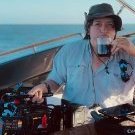First of all it is possible to skip bleach in the negative bath when cross processing reversal film right? For some reason I don't think reversal has silver to wash off of it... and yet it seems to be exposed to bleach in the E-6 process from what I understand. Please enlighten me as to if this alternative processing combo is possible or why it would not be.
I am running this test. I loaded some of the film into a still camera and am looking for a lab in the Philly area to cross process the test I shot, bracketing different types of lights and shooting a range of bright colored objects, neutral colors, and flesh tones under various types of lights. Tungsten, blue flourescent, CTB'd tungsten, Mauve gelled tungsten, old green spiked subway flourescents. I need to shoot a roll in daylight and also, does anyone know a lab that would be able to process it, preferably within the Philadelphia area?
I'll post the test when I get it back.
By the way I am a cinematography student at Temple U in Philly and work in the area as a freelance gaffer/DP. I am very interested in doing a lot of experiments with film processing. I've shot a few short films on various stocks, and some push/pull tests. I am also currently interested in testing flashing film. I'd like to preflash some s16mm 100' loads of the vision 2 stocks 50D, 100T, 200T, and the new vision 3 250D, does anyone know how to run a flash test relatively cheap? I don't know how much to open the aperture while shooting a grey card so that isn't a very sensible test. And I don't think I can spare the money to rent a Panaflasher. Perhaps a lab would be willing to do it for me for a reasonable sum?
I will also try to post these.
I am also interested in doing a test of ENR and ACE processing if there are any suggestions on how exactly to do this economically... is there a still equivalent?
The idea is to eventually combine this knowledge for my friend's film in late May, rather than just run with my intuition to try to find a lab to flash Vision 3 250D (what's the number?) 5%, underexpose it 2 stops, push 1 for night scenes, 2 for day, and ENR it for 35% silver retention. TEST! TEST! TEST!
This website would greatly benefit the art of cinematography by collecting and organizing these types of tests for a reference catalog. It would do so because, it would help save young cinematographers if not us all the money and time we really don't have to spare on extensive and strenuous tests by putting us in the relative ballpark of how a film will look, with an ongoing dialogue about the limits of cinematography itself. This would be much more useful than the standard response of "well test it out and see for yourself. and suit it to your taste" because lets be serious, the greater expanse of aesthetic experience at our disposal, the more refined and more useful our cinematographic taste becomes, which I think is the goal.



